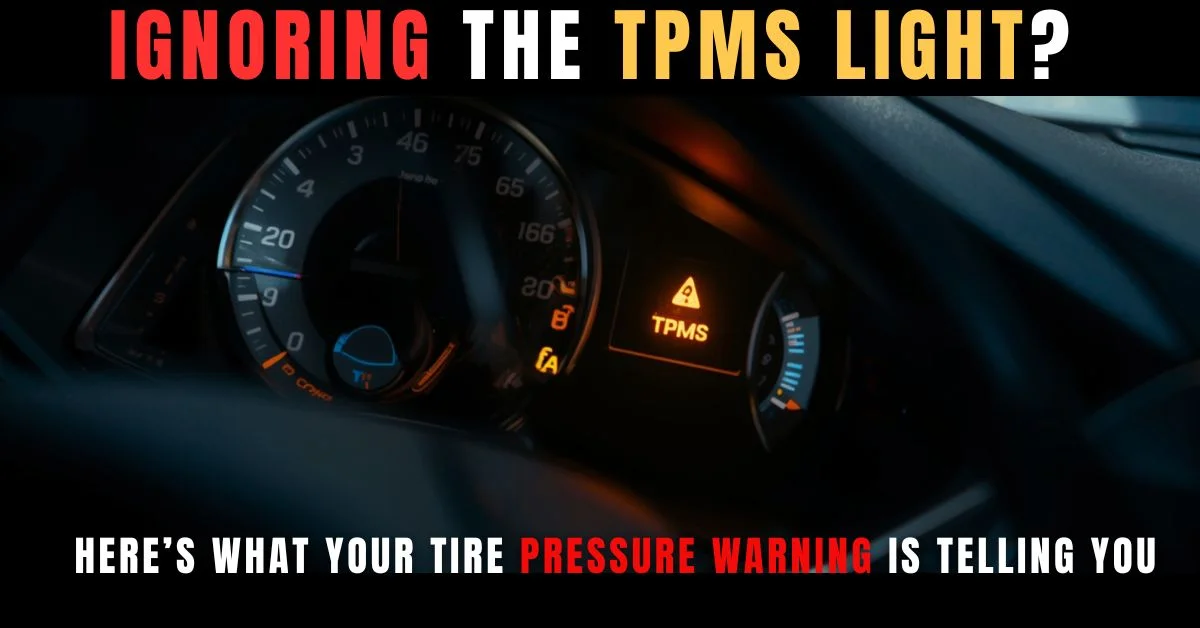If you’re thinking that the amber or yellow tire warning light on your dashboard is no big deal, think again it’s your car’s way of shouting for attention before trouble hits the road. That glowing horseshoe icon known as the TPMS light (Tire Pressure Monitoring System indicator) is your vehicle’s built-in safeguard, alerting you to tire pressure issues that can impact safety, fuel efficiency, and performance. Ignoring it could lead to more than just uneven wear it could compromise your control on the road. In this blog, we’ll discuss what TPMS means, how it gets activated, andhow you should respond when the light comes on, so you can keep your ride safe, efficient, and road-ready.
What Does TPMS Mean?
TPMS meaning refers to the Tire Pressure Monitoring System, a safety feature mandated in vehicles since 2008. This electronic system continuously monitors the air pressure in your tires and alerts you when pressure drops below safe levels. The tyre pressure monitor light typically appears as a horseshoe shape with an exclamation mark in the center, indicating that immediate attention is required.
Types of TPMS Warnings and What They Mean
| Warning Type | Appearance | Meaning | Action Required |
| Steady TPMS Light | Constant amber glow | One or more tires are underinflated | Check and adjust tire pressure immediately |
| Flashing Tire Pressure Light | Blinks for 60-90 seconds, then stays solid | TPMS system malfunction | Visit a professional mechanic for diagnosis |
| Blinking Tire Pressure Light (intermittent) | Periodic flashing | Sensor battery low or system error | Schedule service appointment |
Why Is My Tire Pressure Light Blinking?
A tire pressure light blinkingindicates a different issue than a steady warning. When you notice a flashing tire pressure light that blinks for approximately 60 to 90 seconds before remaining solid, this typically signals a malfunction within the TPMS system itself rather than an actual tire pressure problem.
Common causes of a blinking tire pressure lightinclude:
- Faulty TPMS sensors: Sensors have a battery life of 5-10 years and may fail over time
- Recent tire rotation or replacement: New tires or wheels without properly programmed sensors
- Electronic interference: Aftermarket wheels or sensor communication issues
- Extreme temperature changes: Sudden weather shifts affecting sensor calibration
- System programming errors: Lost sensor synchronization with the vehicle’s computer
The Importance of Addressing TPMS Warnings
Ignoring your TPMS light can lead to serious consequences beyond just another dashboard warning. Underinflated tires create multiple safety and financial concerns:
Safety Risks:
- Increased stopping distances in emergency situations
- Higher risk of tire blowouts, especially at highway speeds
- Reduced vehicle handling and stability during cornering
- Greater likelihood of hydroplaning in wet conditions
Economic Impact:
- Decreased fuel efficiency by up to 3% for every 1 PSI drop in pressure
- Premature tire wear, reducing tire lifespan by up to 25%
- Potential damage to wheel rims and suspension components
- Higher maintenance costs due to uneven tire degradation
How to Respond When Your TPMS Light Activates
When the tyre pressure monitor light illuminates, follow these systematic steps:
- Check tire pressure immediately: Use a reliable tire pressure gauge to measure all four tires plus the spare
- Inflate to recommended levels: Refer to the sticker inside your driver’s door jamb for proper PSI specifications
- Inspect for visible damage: Look for punctures, cuts, or objects embedded in the tread
- Reset the system: Some vehicles require manual TPMS reset after adjustment
- Monitor for recurrence: If the light returns within days, seek professional inspection

If you observe a flashing tire pressure light pattern, avoid attempting DIY repairs. This malfunction requires diagnostic equipment to identify the specific sensor or system component causing the issue.
Maintaining Your TPMS for Optimal Performance
Preventive maintenance ensures your TPMS functions reliably:
- Check tire pressure monthly, even without warning lights
- Have sensors inspected during regular tire rotations
- Replace sensor batteries proactively during tire changes
- Ensure proper sensor installation when purchasing new tires
- Use only TPMS-compatible tire repair methods
Learn more about Car Repair and Maintenance Tips
Conclusion
Understanding your TPMS light and responding promptly to its warnings is essential for safe driving and vehicle maintenance. Whether you’re dealing with a steady warning or a blinking tire pressure light, addressing the issue immediately protects your safety, preserves tire life, and maintains optimal fuel efficiency. Don’t ignore this critical safety feature: your tires are the only contact your vehicle has with the road, making proper tire pressure monitoring one of the most important aspects of vehicle maintenance.
Frequently Asked Questions
Can I drive with the TPMS light on?
While you can technically drive, it’s unsafe. Check and correct tire pressure immediately to avoid potential tire failure.
How much does TPMS sensor replacement cost?
Individual sensors typically range from $50-$150 each, plus installation labor costs of $10-$30 per sensor.
Does cold weather trigger the TPMS light?
Yes, tire pressure drops approximately 1 PSI for every 10°F temperature decrease, which can trigger the warning light.
Will the TPMS light turn off automatically?
Once you correct the tire pressure, the light should turn off after driving a few miles. Some vehicles require manual reset.

